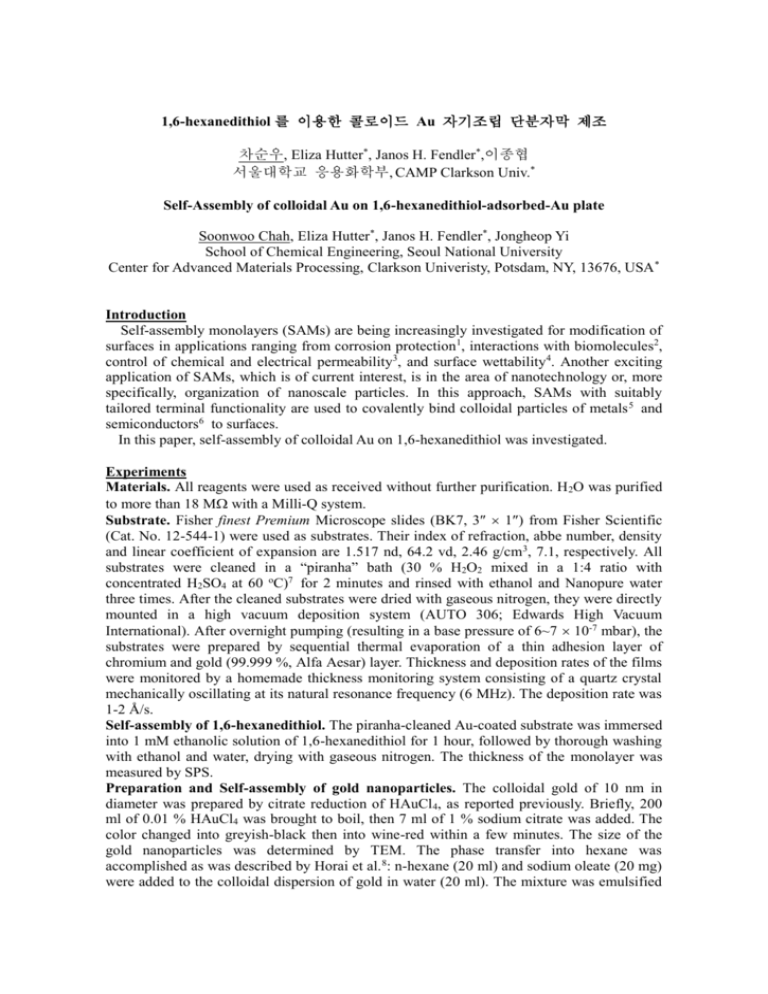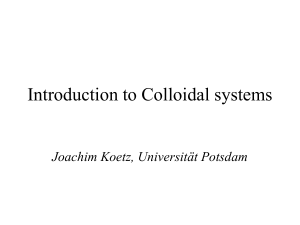Self-Assembly of colloidal Au on 1,6-hexanedithiol-adsorbed
advertisement

1,6-hexanedithiol 를 이용한 콜로이드 Au 자기조립 단분자막 제조 차순우, Eliza Hutter*, Janos H. Fendler*,이종협 서울대학교 응용화학부, CAMP Clarkson Univ.* Self-Assembly of colloidal Au on 1,6-hexanedithiol-adsorbed-Au plate Soonwoo Chah, Eliza Hutter*, Janos H. Fendler*, Jongheop Yi School of Chemical Engineering, Seoul National University Center for Advanced Materials Processing, Clarkson Univeristy, Potsdam, NY, 13676, USA * Introduction Self-assembly monolayers (SAMs) are being increasingly investigated for modification of surfaces in applications ranging from corrosion protection1, interactions with biomolecules2, control of chemical and electrical permeability3, and surface wettability4. Another exciting application of SAMs, which is of current interest, is in the area of nanotechnology or, more specifically, organization of nanoscale particles. In this approach, SAMs with suitably tailored terminal functionality are used to covalently bind colloidal particles of metals 5 and semiconductors6 to surfaces. In this paper, self-assembly of colloidal Au on 1,6-hexanedithiol was investigated. Experiments Materials. All reagents were used as received without further purification. H 2O was purified to more than 18 M with a Milli-Q system. Substrate. Fisher finest Premium Microscope slides (BK7, 3 1) from Fisher Scientific (Cat. No. 12-544-1) were used as substrates. Their index of refraction, abbe number, density and linear coefficient of expansion are 1.517 nd, 64.2 vd, 2.46 g/cm3, 7.1, respectively. All substrates were cleaned in a “piranha” bath (30 % H2O2 mixed in a 1:4 ratio with concentrated H2SO4 at 60 oC)7 for 2 minutes and rinsed with ethanol and Nanopure water three times. After the cleaned substrates were dried with gaseous nitrogen, they were directly mounted in a high vacuum deposition system (AUTO 306; Edwards High Vacuum International). After overnight pumping (resulting in a base pressure of 6~7 10-7 mbar), the substrates were prepared by sequential thermal evaporation of a thin adhesion layer of chromium and gold (99.999 %, Alfa Aesar) layer. Thickness and deposition rates of the films were monitored by a homemade thickness monitoring system consisting of a quartz crystal mechanically oscillating at its natural resonance frequency (6 MHz). The deposition rate was 1-2 Å/s. Self-assembly of 1,6-hexanedithiol. The piranha-cleaned Au-coated substrate was immersed into 1 mM ethanolic solution of 1,6-hexanedithiol for 1 hour, followed by thorough washing with ethanol and water, drying with gaseous nitrogen. The thickness of the monolayer was measured by SPS. Preparation and Self-assembly of gold nanoparticles. The colloidal gold of 10 nm in diameter was prepared by citrate reduction of HAuCl 4, as reported previously. Briefly, 200 ml of 0.01 % HAuCl4 was brought to boil, then 7 ml of 1 % sodium citrate was added. The color changed into greyish-black then into wine-red within a few minutes. The size of the gold nanoparticles was determined by TEM. The phase transfer into hexane was accomplished as was described by Horai et al. 8: n-hexane (20 ml) and sodium oleate (20 mg) were added to the colloidal dispersion of gold in water (20 ml). The mixture was emulsified by vigorous stirring at room temperature for 2 h. Then, magnesium chloride (0.25 g) in water (3 ml) was added with stirring. On standing for 4 h, the mixture was transformed from an emulsion into two liquid layers. The upper layer was a colloidal dispersion of gold in nhexane colored red and the lower layer was a transparent and colorless aqueous solution. Thus, all the colloidal gold particles were virtually transferred from the aqueous phase to the n-hexane phase. The colloidal dispersion of gold in n-hexane was isolated by using a separatory funnel. The substrate with the thiol monolayer on it was immersed into the organic solution of colloidal gold for 7 minutes, then washed thoroughly with ethanol and water. Colloidal Auadsorbed-substrate was dried, and its thickness was measured by SPS. Characterization. Surface Plasmon Spectroscopic (SPS) measurements were carried out on a home-constructed instrument to measure the thickness of layers. Chromium-gold coated glass slides were used as the reflection element. The uncoated side of the slide was brought into optical contact with the base of a 90o glass prism (n = 1.5151) by an index-matching oil (n = 1.5180 0.0005; R.P. Cargille Laboratories, Inc.). A p-polarized light from a HeNe laser (632.8 nm, Hughes, 3235H-PC, 20 mW) was directed to the base of the prism that was mounted on a stepping motor driven rorator (Oriel). The rotator is capable of synchronously varying the angle of incidence, and the direction of a large area silicon detector (Newport 818-SL) with an angle resolution of 0.01o. Each 20s-scan produced a reflectivity vs. incident angle curve. JEOL JEM-1200EXII Transmission Electron Microscope was used to see the size of the prepared colloidal particles. The sample was prepared by dropping colloidal gold with a pipet on a Cu-coated grid and drying in the ambient air. TEM was operated at 120 kV. Hewlett-Packard 8252A absorption spectrophotometry was used to know if the colloidal gold in water were transferred into hexane well. The coverage and morphology of surface were monitored by AFM (Topometrix Explorer 2000 scanning probe microscope in non-contact mode with standard silicon nitride tips, force constant of 0.12 N/m) and SEM (JEOL JSM6300, operating at 15kV). Absorbance Results and Discussion TEM images were taken of the 3.5 colloidal gold nanoparticle dispersions. Colloidal Au in Water 3.0 We could see that 10 nm gold particles Colloidal Au in Hexane were spread everywhere on the grid. 2.5 Transfer of colloidal Au into hexane was investigated by absorption spectro2.0 photometry (Fig. 1). Although there was a little difference in absorbance, the 1.5 shape and maximum wavelength of two peaks were the same. It could be inferred 1.0 that the colloidal gold nanoparticles were transferred into hexane without any 0.5 change. However, we could see some 0.0 precipitation of colloids in solution after 200 300 400 500 600 700 800 900 15 days since they were transferred into Wavelength (nm) hexane. When they were transferred, citric acid on the surface of colloid was Fig. 1. Absorption spectrophotometry for replaced with oleic acid. Then, colloids colloidal gold in water and in hexane (λmax = lose the negative charge to be neutral, so 520 nm). they can be aggregated each other as time goes on. Therefore, I recommend that gold particles should be transferrd when they are Reflectance needed and use as soon as possible. 1.0 Au film Au-HDT Surface plasmon spectroscopy (SPS) Au-HDT-10nm Au 0.8 was used to establish the thickness of the Cr, Au, 1,6-hexanedithiol and gold 0.6 nanoparticles. SPS was know to be a very sensitive thickness-measuring tool 0.4 by sensing refractive index changes near 9 the surface of a metal film . Moreover, it 0.2 was known that SPS data showed the similar results to other measurements 0.0 41 42 43 44 45 46 like quartz crystal microbalance and absorption spectroscopy.10 Fig. 2 shows SPS of each layer on the silica substrate. Fig. 2. Surface Plasmon Spectroscopy of each Angles showing minimum reflectances layer on the silica substrate. Angles showing were 43.0o (Au film), 43.2o (Au-HDT) minimum reflectances were 43.0 (Au film), and 44.1o (Au-HDT-10nm Au), 43.2 (Au-HDT) and 44.1 (Au-HDT-10nm respectively. Fitting the experimentally Au). determined values to theoretical reflectivity curves (based on Fresnel equations) provided data for the thickness, and the real and imaginary parts of the refractive indices of each layer. The results are shown at Table 1. 5 Å of chromium was coated on the silica substrate (BK7), and 343 Å of gold layer was coated on that. The length of 1,6-hexanedithiol was known to be 7 Å, so it is inferred that 1,6hexanedithiol forms uniform monolayer on the gold-coated substrate in 1 hr. The thickness of gold nanoparticle layer could be predicted to be 100 Å, but SPS result showed 40 Å. It was thought that it was caused by the short immersion time (7 min). Table 1. Thickness determination of the layers using SPS. Layers er ei Cr -31.12000 30.35000 Au -11.21900 0.46460 1,6-hexanedithiol 2.32900 0.00000 Gold nanoparticle -8.27800 0.70060 Thickness (Å) 5.00 343.00 7.00 40.00 Analyses such as SEM and AFM were performed to see the surface morphology and how much of the surface was covered with gold nanoparticles. It was seen that there were some particles on the substrate from SEM results (Fig. 3(a)), but gold nanoparticles were too small to analyze the size by SEM image. From AFM data (Fig. 3(b)), we could see that gold particles were distributed on the substrate. Some aggregations were found, and it was thought that it was caused by the aggregation of colloidal gold particles when they were transferred into hexane. Coverage and distribution of particle diameter were analyzed with Image Pro Express on the basis of AFM image. Distribution of particles was shown at Table 2, and surface coverage, average diameter were 51%, 23.4 nm, respectively. The average diameter was larger than the value predicted, and the coverage could be predicted roughly from thickness calculated by SPS data. Table 2. Distribution of particle diameter. D (nm) 0-5 5-10 10-15 No. 0 0 0 15-20 38 20-25 87 25-30 50 30-35 7 35-40 1 (a) (b) Fig. 3. Surface morphology of gold nanoparticle-adsorbed substrate. (a) SEM ( 40,000) (b) AFM (1,456 nm 1,456 nm) Conclusions Colloidal gold monolayer was prepared on 1,6-hexanedithiol-adsorbsed Au substrate by self assembly. The thickness of prepared layer was 5 Å (Cr), 343 Å (Au), 7 Å (1,6-hexanedithiol), 40 Å (colloidal gold), respectively. Surface coverage and average diameter of adsorbed particles were 51%, 23.4 nm. Reference 1 Notoya T., Poling Q. W., Corrosion, 35, 193 (1979) Lopez G. P., Biebuyck H. A., Harter R., Kumar A., Whitesides G. M., J. Am. Chem. Soc., 115, 10774 (1993) 3 Sabatani E., Rubinstein I., J. Phys. Chem., 91, 6663 (1987) 4 Bain C. D., Whitesides G. M., J. Am. Chem. Soc., 110, 5897 (1988) 5 Grabar K. C., Allion K. J., Baker B. E., Bright R. M, Brown K. R., Freeman R. G., Fox A. P., Keating C. D., Musick M. D., Natan M. J., Langmuir, 12, 2353 (1996) 6 Colvin V. L., Goldstein A. N., Alivisatos A. P., J. Am. Chem. Soc., 114, 5221 (1992) 7 Katherine C. Grabar, Patrick C. Smith, Michael D. Musick, Jennifer A. Davis, Daniel G. Walter, Michael A. Jackson, Andrea P. Guthrie, and Michael J. Natan, J. Am. Chem. Soc., 118(5), 1148 (1996) 8 Hirai H., Aizawa H., J. Colloid Interface Sci., 161, 471 (1993) 9 L. Andrew Lyon, William D. Holliway, and Michael J. Natan, Review of Scientific Instruments, 70(4), 2076 (1999) 10 Thierry Cassagneau, Frédéric Guérin and Janos H. Fendler, Langmuir, in press, 2000 2






